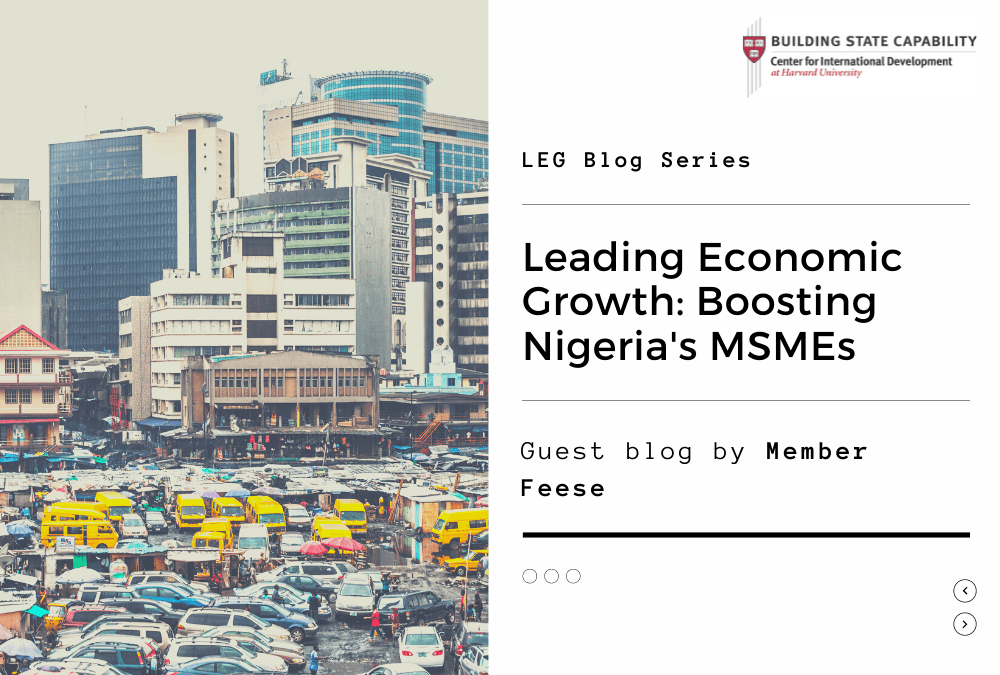Guest blog by Member Feese
My key learning from the Leading Economic Growth course is how to effectively define a challenge / problem using the 5-whys technique and not use the solution to define the problem. For instance, the definition of my first economic problem was lack of transportation infrastructure in Nigeria, however, I discovered that that definition was narrow and did not identify the main problem of why transportation infrastructure was lacking. Using the 5-whys technique, I was able to redirect my challenge to tackling high rates of poverty and low growth rate among Micro, Small and Medium Enterprises (MSMEs), the binding constraint, concentrating on transportation infrastructure. If poverty and growth rate are addressed, transportation facilities will improve.
According to the Nigerian Bureau of Statistics, the level of poverty in Nigeria is currently about 40% of the total population, 83 million people, with MSMEs contributing a large portion of that figure. MSMEs are a primary source of jobs, accounting for about 96% of businesses and 84% employment (PWC, June 2020). However, the economic climate faces challenges of poor infrastructure, unfriendly business environment, high incidence of informal sector, etc., which adversely affects the MSME sector. More specifically, the current COVID-19 pandemic has impacted negatively on the sector, which has affected household livelihoods across the country.
Using the Problem Driven Iterative Adaptation (PDIA) approach, I was able identify the specific problem and proffer solutions. I participated in the Implementing Public Policy course in 2020, where I first learnt about the PDIA. However, I did not fully understand the concept. With the Leading Economic Growth course, getting the ability to use the PDIA again, I understand better, the importance and benefits of scrutinizing a problem.
My economic growth problem is complex, it is similar to the 1804 journey. As a result, PDIA, as opposed to Solution and Leader Driven Change (SLDC), is essential to address the challenge. PDIA provides an avenue to iterate, implement, go back to the drawing board, learn new outcomes, tweak the approach and implement again until you perfect the solution. It provides opportunities to try new things and tweak them as you go along which is necessary for complex challenges. With the help of PDIA, I discovered the importance the transportation industry plays towards the success of MSMEs as transportation links businesses to customers. I worked hard to build authority, ability and acceptance to solve the problem at hand.
Due to neglect of infrastructure facilities in the country, the current facilities available are insufficient to meet demand. Investment in transportation infrastructure has been neglected over the years leading to deterioration of facilities and a rot in the system. Infrastructure investment has not been prioritized leading to low budget allocation and lack of maintenance.
The gap between the rich and the poor is widening, and I believe the lack of access to transportation facilities is exasperating the problem. Without efficient transportation, farmers and entrepreneurs will be unable to transport their goods to the markets. The Nigerian transportation system is plagued with bad roads, inadequate fleets, delays and congested ports. In a country of over 200 million people, there are only 3 functioning railway routes and 6 seaports with only 1 functioning to full capacity. The size of the industry has been growing over the years but it is still not efficient to ensure growth.
The problem of lack of transportation facilities and high poverty rate among MSMEs is known but the solutions implemented over the years to address the problem have failed. Nigeria lacks the needed transportation facilities to enable the country to grow and reduce the level of poverty. Recently, the Federal Government has prioritized investment in transportation infrastructure but it has not been sufficient. Lack of efficient resources, decay, corruption and insecurity have been the bane of the sector. Insecurity in particular has drastically affected the investments and the growth of the industry. There is a need to address insecurity before increasing investments to avoid draining resources.
Another key insight was navigating the product space with the Atlas of Economic Complexity. From the Atlas of Economic Complexity, I discovered that exports in Nigeria are concentrated highly on petroleum oils and crude, accounting for 77.62%, and petroleum gas, accounting for 11.86% of total exports.
Over the years, Nigeria’s per capita income has been unstable. With the discovery of oil in the 1960s and the global financial crisis in 2008, per capita income fluctuated. Between 2009 and 2014, per capital income grew to its highest level, peaking at over 3,000 in 2014. However, since 2014, per capita income has declined due to unstable oil prices with the Nigerian economy being heavily dependent on oil. This has greatly affected the inclusion rate and the government’s ability to budget effectively and allocate sufficient resources for infrastructure.
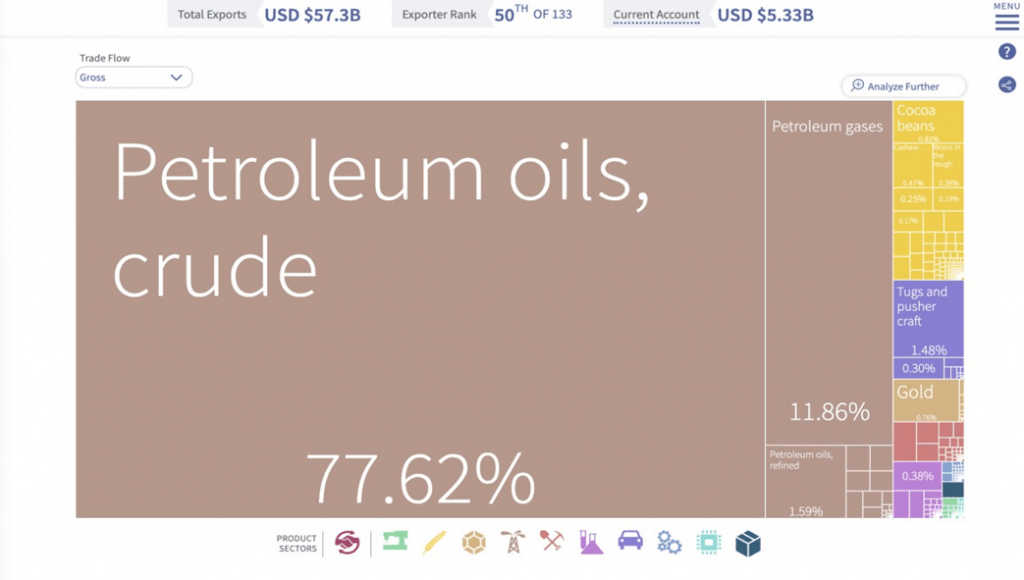
Nigeria has an Economic Complexity Index (ECI) of -1.90 which means that Nigeria’s exports are not complex enough for its expected income level, as a result, the economy is growly slowly or not growing at all. Over the last 5 years, exports have declined by an average of 8.9% affecting the country’s growth.
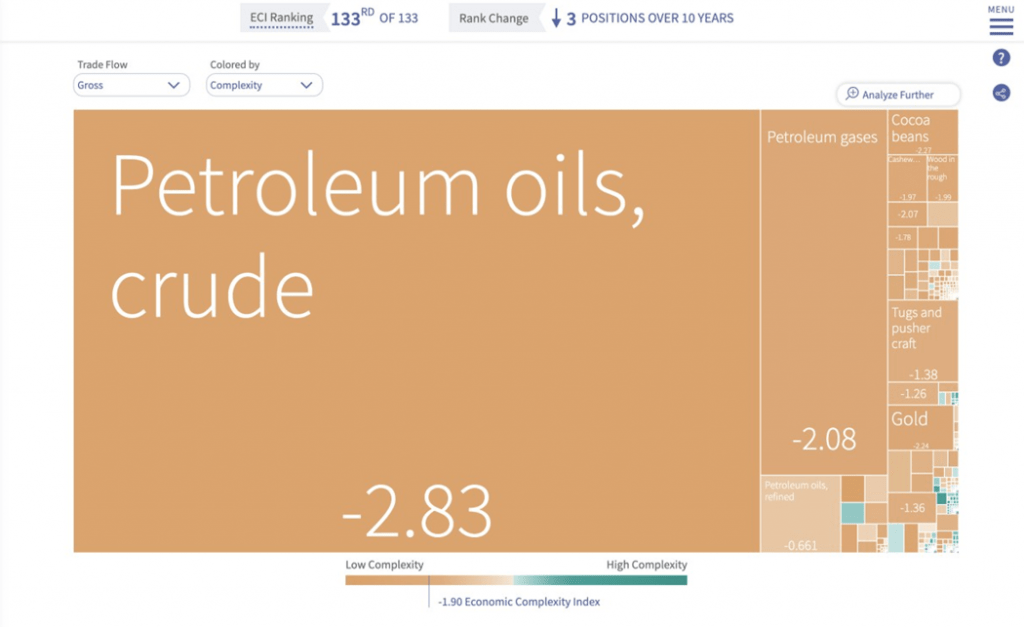
I discovered that Nigeria does not have enough diversity according to product space with just a few products at the periphery, as shown below. The biggest spots are petroleum products and agriculture. This justifies the necessity of infrastructure to help boost the economy by linking petrol products from refineries to ports for distribution and agricultural products to markets.
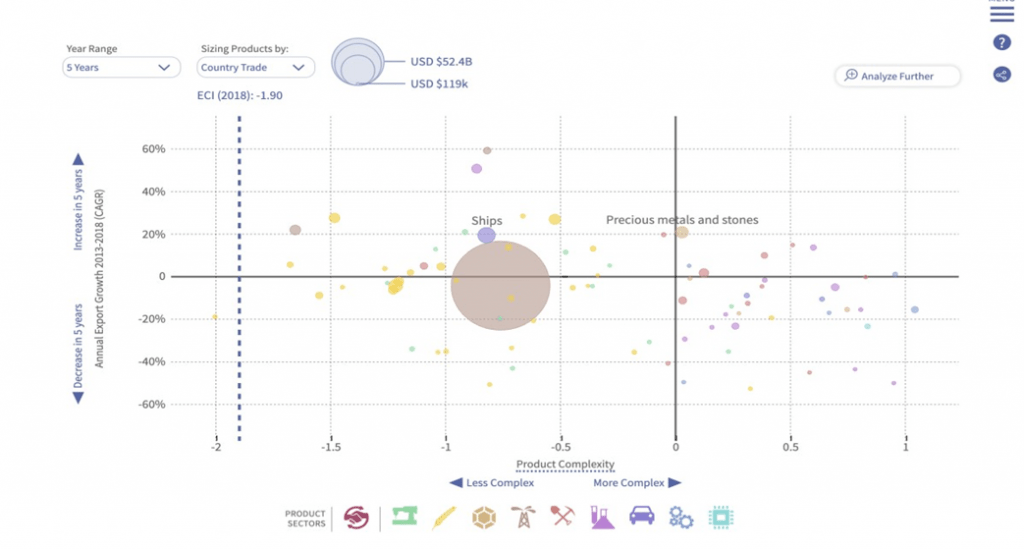
From the Strategic Setting template, I learnt that Nigeria is in Bridge over troubled waters, the bottom left quadrant of the chart, which means that the country needs to acquire more letters but it is finding it difficult to achieve. It is experiencing low relative complexity and it is not well connected. This presents a challenge as it limits growth. Its productive capacity falls short from encouraging growth. Nigeria is not sufficiently complex to grow the country’s income and not well-connected to accommodate many new opportunities. It will need a Strategic Bets Approach to overcome complexity. The country needs to aggressively focus on diversification and infrastructure investment to encourage growth. The economy is heavily dependent on oil and with the recent fluctuations in the international market the level of growth has been greatly affected. The government is currently encouraging agriculture, however, there are insufficient transportation facilities to transport produce from farm to markets.

With my growth challenged solved, the Nigerian GDP will improve as transportation facilities play an important role on the success of MSMEs as it links businesses to customers. There will be easy movement of people, goods and services around the country, the level of poverty and in turn insecurity will decline.
My economic growth challenge existed before participating in the course, however, the course has given me useful theories and tools to address my challenge and various challenges related to economic development. The course gave me an opportunity to interact with peers tackling similar and different growth challenges and exchange ideas. I learnt that it is important to work, reflect, strategize and chart a way forward when addressing complex challenges. As a development economist, the course has been a revision and updated my economic development knowledge. It has helped me rebuild my capacity and look at scenarios from a different perspective.
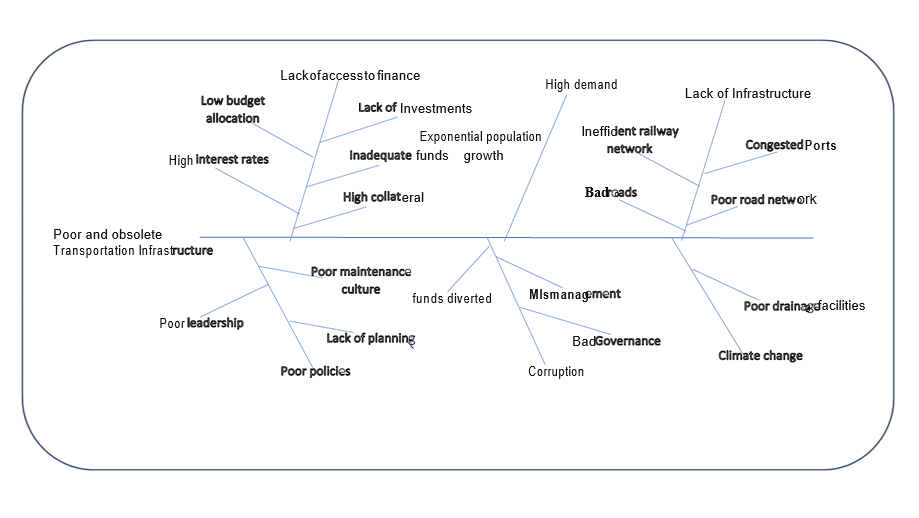
This is a blog series written by the alumni of the Leading Economic Growth Executive Education Program at the Harvard Kennedy School. 65 Participants successfully completed this 10-week online course in May 2021. These are their learning journey stories.
To learn more about Leading Economic Growth (LEG) watch the faculty video, and visit the course website.
